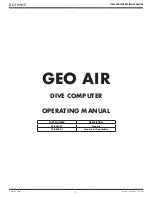
4
for the X face, which is to the left of the probe’s notch (notch = black triangle in the image). Suppose that the offset is
presently correct. If so, then if the probe is laid on a nonmag-netic table with the X face pointing downward (i.e., with
the X face in contact with the table), it will accurately display the vertical component of the Earth magnetic field at
that location. In the northern hemisphere, this vertical component generally is downward (while the horizontal
component points approximately to the north). In this configuration of the meter and probe, the X face is pointing
downward and the meter is displaying the X value. Therefore the meter is presently reading the
vertical
component
of the field. In the northern hemisphere, it should read a negative number (typically around -0.40 gauss).
If the probe is then flipped 180° (as a pancake would be flipped) so that the X face is upward, then the meter should
read the
negative
of the previous number. For example, if it had read -0.40 when facing downward, it should now
read 0.40 (without a negative sign) when facing upward. Whenever there is no error in the zero offset, a single axis
reading, when flipped 180° about that axis, should remain the same number except that the sign will reverse.
Now suppose that the offset were
not
properly zeroed, at least in the X axis. Suppose that the X value is off by -0.15
gauss, so in true zero field, X reads -0.15 gauss. This would mean in the above example that when the X face is
upward, instead of reading 0.40 gauss, it would read 0.25 gauss. Similarly, when face-down it would read -0.55
gauss (which is 0.15 gauss
more negative
than the true value of -0.40). Because 0.25 and -0.55 are not negatives of
each other, we know that the offset is not set properly in this example.
The OFFSET knob can be used to change the offset of each of X,Y,Z. However, these three offsets can only be
modified while viewing X,Y, or Z on the “Measure” mode, and then pushing
downward
on the OFFSET knob so a
triangle appears in the display over the words “Offset Adjust” on the label. After turning the left knob to “Measure”,
pressing “View” to select X, Y, or Z, and pressing down on the OFFSET knob so a triangle appears over the words
“Offset Adjust”, then by rotating the OFFSET knob, you can change the offset on the axis (X, Y, or Z) that is being
viewed. Turning clockwise will add; CCW will subtract. It is 0.01 gauss per click of the knob and there are 24 clicks
per rotation. The effect of the offset is displayed immediately. For example, if X is stable and reading -0.15 gauss,
and then the knob is turned 2 turns CW, the reading will become -0.15 + 0.48 = 0.33 gauss. You can press
“
Reset
”
while in this mode to restore the factory offsets. Once these offsets are modified, they will be remembered until new
offsets are entered.
The triangle is removed by pressing OFFSET again, or by toggling the view back to “Magnitude” (magnitude does
not technically have a its own offset; it is a computed variable taken from the measured values of X,Y,Z so its offset
cannot be adjusted). The triangle is also removed if the left knob is turned to “Peak Hold” (or of course to OFF).
To adjust for zero offset, view X and press down on OFFSET so the “Offset Adjust” triangle appears, as above. Lay
the X face of the probe on the table (facing down) and note the reading. Then flip the probe 180° so the X face is up.
Note this and then compute the average of the two numbers. This average is the offset error of X. For example, if the
first number was -0.43 and the second was 0.43, then the average is zero and there is no offset error. If the numbers
are instead 0.25 and -0.55 (as in a previous example), the average is -0.15 so that 0.15 would need to be added to
the X offset to correct it. This amount is added by turning the OFFSET knob 15 clicks clockwise. If the two numbers
are 1.50 and 1.70, the offset error is 1.60, so the knob must be turned CCW 6 complete rot 16 clicks. When
offset is adjusted correctly, the two numbers will be the same amount but of opposite signs (subject to the 0.02 gauss
jitter). Note and remember the final value when the X face is downward, which is the correct value of the vertical field
component. Knowing this value will make the Y and Z offset corrections simpler to do.
To correct Y for zero offset, press “View” to display Y and lay the Y face downward on the table. If the Y offset is
correct, it will read the same number as the X did when X was facing downward (assuming the X offset was first
corrected). Rotate the OFFSET knob until Y reads this number (the vertical field). You can confirm that the
adjustment is correct by flipping Y so it is face-up; the number should reverse sign just as X did, and both numbers
should be the same as the numbers for X. To correct Z, press “View” to display Z, lay the top surface of the probe
(the Z face) against the table, so that the probe is vertical, and rotate OFFSET so that Z reads the same number as
X did (when X was face-down). Now press downward on the OFFSET knob to remove the triangle, and the offset
adjustment is done. (Accidentally turning the OFFSET knob will now not affect anything.)























